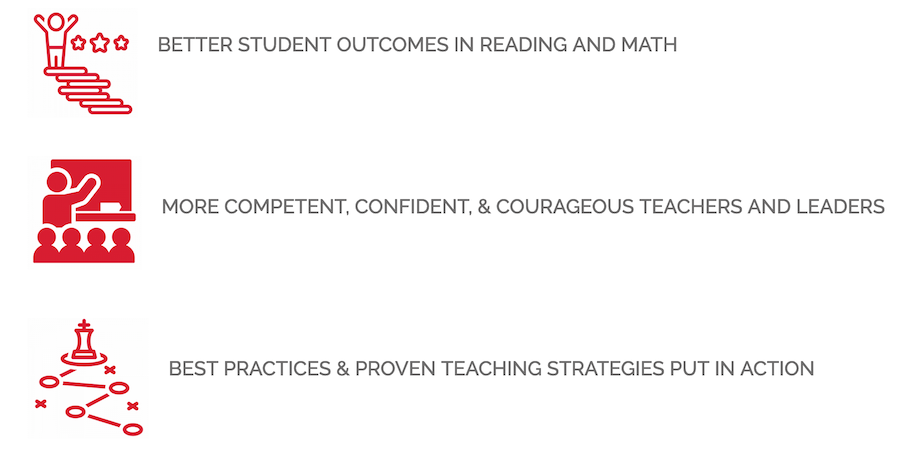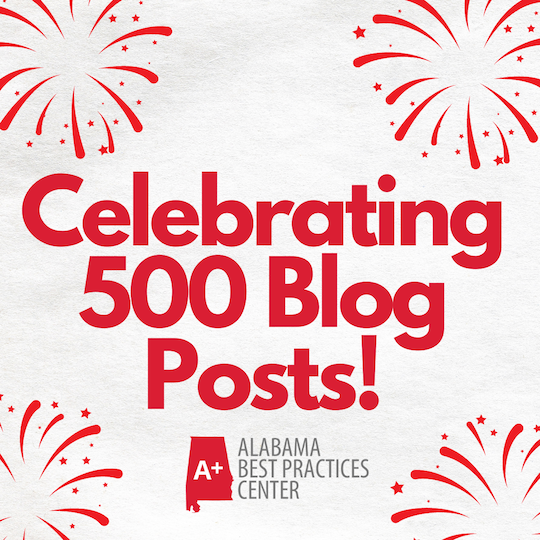 In so many ways, 2020 has been a year many of us would like to forget or at least put behind us. At the same time, we know schools and districts across Alabama are finding silver linings and reasons to celebrate. And so are we.
In so many ways, 2020 has been a year many of us would like to forget or at least put behind us. At the same time, we know schools and districts across Alabama are finding silver linings and reasons to celebrate. And so are we.
First, welcome to our 500th ABPC Blog post!
When Program Coordinator Dakota Punzel told me that number last week, my first reaction was to wonder how in the world we’d managed to create so many, with all the other work we do. But I quickly realized that WE didn’t do it all. We benefited from a gift — the willingness of so many educators involved in our networks who took the time to write for us and tell their stories of positive change, innovation, professional growth and student success.
We’ve picked a few “most-read” posts from among our 500 to share below. But first I want to tell you about our other big reason to celebrate — the very encouraging results from our latest external evaluation.
Deep engagement in ABPC programs improves teaching and learning
From our earliest days, evaluating the impact of our work – with the goal of continuously improving what we do – has been an high priority for the Alabama Best Practices Center. Most recently we contracted with Shore Research/Agile Analytics, in Austin Texas to conduct an independent review of ABPC programs and networks.
The results are cause for more celebration! Their comprehensive external evaluation determined that districts and schools involved deeply in the work of the Alabama Best Practices Center improved both teaching and learning.
The evaluation process included visits and interviews to four districts: Athens, Florence, Oxford, and Saraland, where extensive interviews and focus groups were held. Researchers poured over data ranging from implementation of practices learned or strengthened through participation in the networks to actual student achievement data.
 Specifically, the evaluation found that students who attended the four spotlighted districts had consistently better performance on state assessments among the various models used to examine the impact of ABPC best practices on student achievement – and this was true even when demographics and prior achievement were controlled.
Specifically, the evaluation found that students who attended the four spotlighted districts had consistently better performance on state assessments among the various models used to examine the impact of ABPC best practices on student achievement – and this was true even when demographics and prior achievement were controlled.
Although results for math were stronger than those for reading, there were consistent gains in both subject areas for students attending ABPC spotlight schools versus students attending matched comparison schools.
The Five Key Practices
As they went about their research and evaluation, the Shore Research team identified five key practices that “were consistently observed in the four districts studied and were attributed to their success by district personnel and ABPC staff.”
They summarized the five practices this way:
✻ Professional Learning — ABPC networks provide participants with ongoing professional learning that they can immediately use. Session facilitators model effective teaching practice so participants leave with expanded knowledge and instructional strategies. One district administrator noted the ABPC networks as “The best professional development I have ever attended, bar none.”
✻ Networking — Networking and community building was one of the most frequently mentioned positive components of participants’ professional learning with the ABPC. Connections made at ABPC sessions result in school and districts sharing best practices both in and after the meetings, resulting in better teaching and learning.
✻ Collaborative Planning — Those interviewed consistently mentioned the value of working collaboratively, sharing leadership, and learning and planning and its impact on improved results. This type of lateral accountability stretches participants and exposes them to the effective practices of others.
✻ Coaching and Partnering — The ABPC provides instructional coaches, teacher leaders and administrators with coaching skills and best practice that enables them to partner with teachers to improve instruction.
✻ Effective Teaching and Learning Strategies — ABPC consistently provides participants with strategies and best practice to improve teaching and learning. This learning is not limited to network meetings as the ABPC regularly publishes blogs and uses social media to provide educators with just-in-time learning about key instructional issues.
Our celebration of these results includes celebrating the opportunity we have had to partner and collaborate with the teachers, coaches, principals and district leaders who have participated in the Key Leaders and Powerful Conversations Networks during nearly two decades of professional learning experiences. One core message running through all these results is this: We are better together!
If you’d like to read the complete evaluation, download it here.
And you’ll find the case studies of the spotlighted districts here: Athens City Schools, Florence City Schools, Oxford City Schools, and Saraland City Schools.
And Now, a Few of Those 500 Blog Posts!
Choosing a small sample of the wonderful articles written by guest contributors to the ABPC Blog is challenging, to say the least. I’ve asked our long-time blog editor John Norton to select several that reflect in some way the five key practices identified in our recent independent evaluation.
How We Can Help Young Students Grow Their Mindset – First grade teacher Tammy Smitherman wrote this blog for us in April 2020, about a teaching project she shared at a Powerful Conversations Network table fair. A cheerful and encouraging read, early in the pandemic.
Rock Quarry Elementary’s Transformative Journey – Principal Laura Jockisch began her 2017 guest article this way: “We have experienced amazing growth over the last few years. Our journey with the Alabama Best Practices Center’s Powerful Conversations Network (PCN) has challenged the way we think about student learning and changed the way we approach instruction. Let me share some of our story….”
The Ripple Effect of Instructional Rounds – ABPC has sponsored Instructional Rounds in a variety of schools across Alabama. Bryan Rebar, instructional partner at Florence Middle School, shared what it’s like to experience the IR process in your own building and highlighted the positive ripple effects for his school.
The Sorting: A Six-House System Unites Mill Creek Elementary’s Expanding Community – Who can resist reading about a Hogwarts-themed school? This 2018 article by Principal Carmen Buchanan described how a combination of Houses and “Families” promoted mentoring, positive relationships among faculty and students, a sense of school pride, and a framework for character education. One of our most-read of all time.
Teachers at Athens Middle School Taking Action on Social-Emotional Learning – Instructional Partner Ana Rosales led her readers through a story of impactful teacher collaboration that began when six AMS educators took part in a Powerful Conversations Network meeting that focused on the Fisher-Frey book All Learning Is Social and Emotional.
Cathy again: Just a year ago (it seems so much longer!) we put together an article sharing comments from Key Leaders Network participants about the value of the experience. The insights shared by Greg Edge, principal of Attalla Elementary School, match the findings of our recent outside evaluators so precisely that I thought we’d close with this particular post.
Why Do We Need the Alabama Best Practices Center?
Thanks to Greg and so many other leaders and KLN participants who have informed and educated us along the way.
ALSO SEE:
► 10 of Our Most-Read ABPC Blog Posts of All Time
► Our ABPC Blog Library (all of our posts, sorted by category)


0 Comments on "The New ABPC External Evaluation: A Powerful Affirmation of Our Work Together"